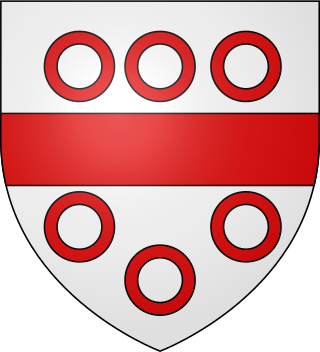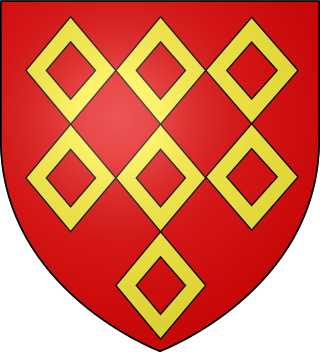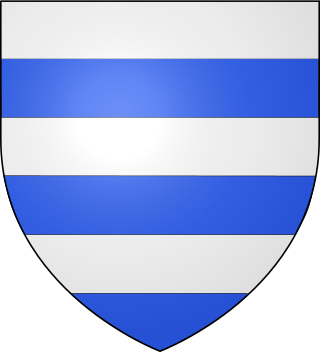Related Research Articles
Thomas Grey, 1st Marquess of Dorset, 1st Earl of Huntingdon, 7th Baron Ferrers of Groby, was an English nobleman, courtier and the eldest son of Elizabeth Woodville and her first husband Sir John Grey of Groby. Her second marriage to King Edward IV made her Queen of England, thus elevating Grey's status at court and in the realm as the stepson of the King. Through his mother's assiduous endeavours, he made two materially advantageous marriages to wealthy heiresses, the King's niece Anne Holland and the King’s cousin, Cecily Bonville, 7th Baroness Harington. By the latter, he had 14 children.

Duke of Suffolk is a title that has been created three times in the peerage of England.

Baron Hastings is a title that has been created three times. The first creation was in the Peerage of England in 1290, and is extant. The second creation was in the Peerage of England in 1299, and became extinct on the death of the first holder in c. 1314. The third creation was in the Peerage of England in 1461, and has been in abeyance since 1960.
The title of Baron Grey of Codnor is a title in the peerage of England.

Baron Lucas is a title that has been created twice in the Peerage of England. The second creation is extant and is currently held with the title Lord Dingwall in the Peerage of Scotland.
The title Marquess of Dorset has been created three times in the Peerage of England. It was first created in 1397 for John Beaufort, 1st Earl of Somerset, but he lost the title two years later. It was then created in 1442 for Edmund Beaufort, 1st Earl of Dorset, who was created Duke of Somerset in 1448. That creation was attainted in 1463.

Baron Grey de Wilton is a title that has been created twice, once in the Peerage of England (1295) and once in the Peerage of Great Britain (1784). The first creation was forfeit and the second creation is extinct.

Earl of Stamford was a title in the Peerage of England. It was created in 1628 for Henry Grey, 2nd Baron Grey of Groby. This Grey family descended through Lord John Grey, of Pirgo, Essex, younger son of Thomas Grey, 2nd Marquess of Dorset, and younger brother of Henry Grey, 1st Duke of Suffolk ; Suffolk was executed for treason in 1554 forfeiting his titles.

Reynold Grey, 3rd Baron Grey of Ruthyn, a powerful Welsh marcher lord, succeeded to the title on his father's death in July 1388.

Baron Ferrers of Groby was a title in the Peerage of England. It was created by writ on 29 December 1299 when William Ferrers, 1st Baron Ferrers of Groby was summoned to parliament. He was the son of Sir William de Ferrers, Knt., of Groby, Leicestershire, (d.1287) by his first wife Anne Durward, 2nd daughter of Alan Durward and his wife Margery of Scotland, and grandson of William de Ferrers, 5th Earl of Derby. The first Baron was married to Ellen de Menteith, daughter of Alexander, Earl of Menteith. In 1475 the eighth baron was created the Marquess of Dorset, and the barony in effect merged with the marquessate. It was forfeited along with the marquessate when the third marquess was attainted in 1554.

The titles Baron Montacute or Baron Montagu were created several times in the Peerage of England for members of the House of Montagu. The family name was Latinised to de Monte Acuto, meaning "from the sharp mountain"; the French form is an ancient spelling of mont aigu, with identical meaning.

The title of Baron Bonville was created once in the Peerage of England. On 10 March 1449, Sir William Bonville II was summoned to Parliament. On his death in 1461, the barony was inherited by his great-granddaughter Cecily Bonville, who two months before succeeded as Baroness Harington, with which title the barony merged until 1554, when both baronies were forfeited. From her death in 1529 to the forfeiture in 1554, the baronies were merged with the title of Marquess of Dorset.

Sir John Grey, of Groby, Leicestershire was a Lancastrian knight, the first husband of Elizabeth Woodville who later married King Edward IV of England, and great-great-grandfather of Lady Jane Grey.

John Paulet, 2nd Marquess of Winchester, styled The Honourable John Paulet between 1539 and 1550, Lord St John between 1550 and 1551 and Earl of Wiltshire between 1551 and 1555, was an English peer. He was the eldest son of William Paulet, 1st Marquess of Winchester and Elizabeth Capel.

Thomas Grey, 2nd Marquess of Dorset was an English peer, courtier, soldier and landowner of the House of Grey.

Sir Henry de Grey of Grays Thurrock, Essex (1155–1219) was a favourite courtier of King John of England.
Henry Grey, 1st Lord Grey of Groby was an English landowner, soldier, courtier, magistrate, county administrator, and member of parliament.
Lord John Grey was an English nobleman and courtier of the Tudor period, who after 1559 was seated at Pirgo Place in Essex.

The House of Grey is an ancient English noble family from Creully in Normandy. The founder of the House of Grey was Anchetil de Greye, a Norman chevalier and vassal of William FitzOsbern, 1st Earl of Hereford, one of the few proven companions of William the Conqueror known to have fought at the Battle of Hastings in 1066.

Henry Ferrers, 4th Baron Ferrers of Groby (1356–1388) was a fourteenth-century English nobleman. He was a professional soldier, taking part in a number of campaigns during the reign of Richard II, served on several royal commissions, was a justice of the peace and a member of parliament.
References
- The Complete Peerage of England, Scotland, Ireland, Great Britain, and the United Kingdom Extant, Extinct, or Dormant ; first edition by George Edward Cokayne, Clarenceux King of Arms; 2nd edition revised by the Hon. Vicary Gibbs et al.
- Burke's Dormant and Extinct Peerages (1978)